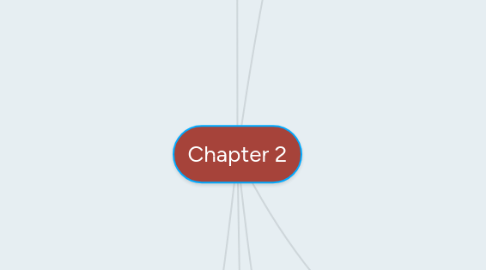
1. SOFTWARE
1.1. Text editing and word processing tools
1.1.1. Word processors
1.1.1.1. Microsoft Word
1.1.1.2. WordPerfect
1.1.1.2.1. Spell checkers
1.1.1.2.2. Table formatters
1.1.1.2.3. Prebuilt templates for letters
1.1.1.2.4. Resumes
1.1.1.2.5. Purchase orders
1.1.2. OpenOffice
1.1.2.1. free, downloadable word processing program
1.2. OCR software
1.2.1. makes use of probability and expert system algorithms
1.2.2. very accurate and saves time and effort
1.3. Painting tools
1.3.1. create and modify bitmap images
1.3.1.1. Photoshop
1.3.1.2. Fireworks
1.3.1.3. Painter
1.4. Drawing tools
1.4.1. create and modify vector graphics
1.4.1.1. CorelDraw
1.4.1.2. Illustrator
1.4.1.3. Canvas
1.5. 3-D modeling tools
1.5.1. VectorWorks
1.5.2. AutoDesk Maya
1.5.3. Strata 3D
1.6. Image editing tools
1.6.1. powerful tools for
1.6.1.1. enhancing retouching
1.6.1.2. blurring
1.6.1.3. sharpening
1.6.1.4. lightening existing bitmapped images
1.7. Sound editing tools
1.7.1. cut
1.7.2. copy
1.7.3. paste
1.7.4. edit certain segments of music
1.8. Animation, video, and digital movie tools
2. AUTHORING SYSTEMS
2.1. allow developers to organize and edit multimedia elements of multimedia project
2.2. Types of authoring tools
2.2.1. Card- and page-based authoring tools
2.2.2. Icon- and object-based authoring tools
2.2.3. Time-based authoring tools
2.3. Objects
2.3.1. each objects is assigned properties or modifiers
2.4. Choosing an authoring tool
2.4.1. Editing and organizing features
2.4.2. Programming features
2.4.3. Interactivity features
2.4.4. Performance tuning and playback features
2.4.5. Delivery, cross-platform, and internet playability features
2.5. Editing and organizing features
2.5.1. to create, edit, and convert multimedia elements
2.5.1.1. animation
2.5.1.2. video clips
2.6. Programming features
2.6.1. Visual programming with icons or objects
2.6.1.1. the simplest and easiest authoring process
2.6.2. example
2.6.2.1. Flash
2.6.2.2. Livecode
2.6.2.3. Toolbook
2.7. Interactivity features
2.7.1. gives the end user control over the content and flow of information in a project
2.8. Performance-tuning
2.8.1. achieving synchronization is difficult, authoring system should facilitate precise timing of events
2.9. Playback features
2.9.1. enable developers to build part of project and test it immediately
2.10. Delivery features
2.10.1. Run-time or stand-alone version
2.10.1.1. allows a project to be executed without authoring software
2.11. Cross-platform
2.11.1. important to use tools that facilitate easy transfer across platforms
2.11.1.1. from Macintosh to Windows
2.12. Internet-playability features
2.12.1. provide a means for converting their output to be delivered within the context of HTML or DHTML
3. DEVELOPMENT PROCESS
3.1. planning
3.2. designing
3.3. testing
3.3.1. Alpha testing
3.3.2. Beta testing
3.4. delivering
4. HARDWARE
4.1. Production platforms
4.1.1. Macintosh
4.1.2. Windows PC
4.2. Connections
4.2.1. Integrated Drive Electronics (IDE)
4.2.1.1. a standard interface for connecting a motherboard to storage devices
4.2.1.1.1. hard drives
4.2.1.1.2. CD-ROM
4.2.1.1.3. DVD drives
4.2.2. Universal Serial Bus (USB)
4.2.2.1. most popular connection used to connect a computer to devices
4.2.2.1.1. digital cameras
4.2.2.1.2. printers
4.2.2.1.3. scanners
4.2.3. FireWire (IEEE 1 394)
4.2.3.1. for connecting devices to personal computer and introduces by Apple in the 1980s
4.3. Memory and storage devices
4.3.1. Random access memory (RAM)
4.3.1.1. Volatile storage
4.3.1.2. enables the simultaneous running of many applications.
4.3.1.3. storage that allows to read and write data as many time as needed
4.3.2. Read-only memory (ROM)
4.3.2.1. Nonvolatile storage
4.3.2.2. BIOS program that boots up the computers resides in the ROM
4.3.3. Hard disks
4.3.3.1. Nonvolatile storage
4.3.3.2. Rewriteable permanent memory
4.3.3.3. high data storage capacity and transfer speed
4.3.4. Flash or thumb drives
4.3.5. CD-ROM
4.3.6. DVD
4.3.7. Blu-ray discs
4.4. Input Devices
4.4.1. Optical character recognition (OCR)
4.4.2. Universal Product Code (UPC)
4.4.3. Microphones
4.4.4. Digital cameras
4.5. Output devices
4.5.1. Stereo
4.5.2. Monitor
4.5.3. Projector
4.5.4. Printer
5. INTANGIBLE ASSETS
5.1. creativity
5.2. organization
5.3. communication
6. MULTIMEDIA SKILLS
6.1. main role
6.1.1. project manager
6.1.1.1. leader of a project
6.1.2. multimedia designer
6.1.2.1. looks at the overall content of a project
6.1.3. interface designer
6.1.3.1. in charge of designing each screen or page interface
6.1.4. writer
6.1.4.1. create characters and actors/ narration
6.1.5. audio / video specialist
6.1.5.1. focus on audio and video production
6.1.6. multimedia programmer
6.1.6.1. integrate all the elements of the project

